
views
Giving a Proper Bath

Use lukewarm water. In a sink or bathtub, fill the bottom with a few inches of lukewarm water. You don’t want the water to be cold, but you don’t want it to be too hot, either. Lukewarm water will be the most comfortable for the cat, and won’t be too shocking or startling for it when you place the cat in the water.

Hold the cat by its scruff. When placing the cat in the tub, hold the cat gently by the scruff on the back of its neck. Ask the friend helping you to gently hold the cat’s back end. If the cat is especially angry, it will be especially important to keep it as still as you possibly can. However, you want to be as gentle as possible so you don’t injure or scare the cat. Keep the door shut. Wherever you’re bathing the cat, try to keep the cat contained in that space, in the event that the cat does break loose from your grip and jump out of the tub.
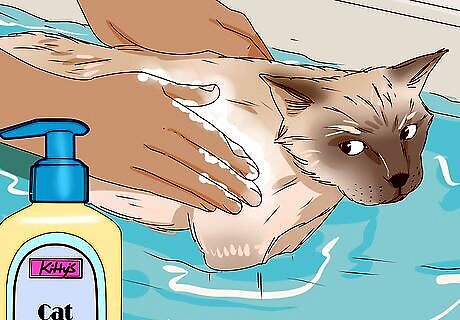
Apply shampoo gently. After you use a spray nozzle or cup to wet down the cat’s fur, apply the shampoo. While your friend helps you hold the cat in place, gently apply shampoo and massage it into its fur. If your cat has very thick or long fur, you can dilute the shampoo to keep the cat’s fur from getting too sudsy. Try using one part shampoo with five parts water, then apply that diluted version to your cat’s fur. Avoid getting water or shampoo on your cat’s face, or in its ears. When wetting the cat down, spray or pour water away from its face. Use the damp washcloth you have handy, instead, to gently wipe the cat’s face clean.

Rinse thoroughly from head to tail. Again, take care to keep soap and water away from your cat’s face when rinsing out the shampoo. Using your hand, gently push water and shampoo out of the cat’s fur in the direction of hair growth as you rinse. This will help ensure you get all the suds out, and will also help eliminate excess water from the cat’s fur as you rinse. It’s important you make sure to rinse out all the soap. Leftover residue from soap can irritate your cat’s skin, causing the cat to feel itchy and scratch at himself. It can also be a bit sticky, and make more dirt end up clinging to the cat’s fur even after it’s dry.

Wrap the cat in a big, dry towel. Once you’ve thoroughly rinsed out all the shampoo, try to gently remove excess water by running your hand down the cat’s fur in the direction of hair growth. Use your hand like a squeegee to help get rid of extra water. Then, have your friend help you wrap up the cat in the towel you have ready. Wrap him tightly, but not too tight. Make sure he can breathe well, but that he can’t escape. Keep the cat wrapped up to allow its fur to dry as much as possible. While the cat dries, try to keep it in a room that is warm, without any cold drafts or breezes from fans or open windows. If you want to try and use a blow dryer on the cat, make sure you keep it on its lowest heat setting. You won’t want to accidentally burn the cat’s sensitive skin.
Maintaining Cleanliness Between Baths

Remember that cats are usually self-cleaning. For the most part, cats are very good at keeping themselves clean. You should really only need to bathe them if they get especially dirty, or if they have a condition that requires you to bathe them more often. Your vet will advise you if your cat needs to be bathed often.

Keep the cat brushed. Brushing your cat regularly is a good way to keep it clean without giving it a bath. Brushing removes knots, mats, and debris from your cat’s fur. It also can improve the health of your cat’s skin overall, by helping to stimulate blood circulation, and getting rid of dead or loose fur and excess grease and oil. Use a brush designed for cats, and be gentle. If you find a mat or knot that cannot easily be brushed out, carefully trim them out. Regular brushing to remove dead or excess hair can also help keep your cat from coughing up hairballs from self-grooming. When brushing, monitor your cat’s skin and hair for signs of excess shedding, fleas, ticks, or skin infections. If you notice any of these things, or anything abnormal, talk to your vet.

Use a damp washcloth to spot clean when necessary. Instead of immediately putting your cat in the bathtub if you notice some dirt on its fur, simply use a dampened washcloth to wipe it away. Not only will this prevent the drama that can sometimes come from trying to bathe a cat that doesn’t want to be bathed, it can also help prevent excess skin drying from bathing your cat too often.
Preparing for the Bath
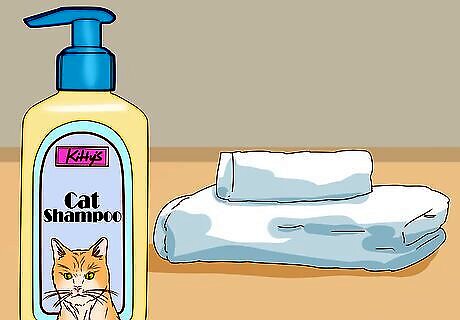
Gather your materials. When trying to bathe an upset cat, it’s important you have everything ready before beginning. The angry cat will likely be looking for any opportunity to escape the bath, so leaving him alone to go grab a supply you forgot will probably result in a wet, soapy cat running around freely. Before taking your cat to the bath, get your cat shampoo, towels, and a washcloth ready. Have these things handy beside the tub. Consider placing a rubber bath mat on the floor of the sink or tub you will be bathing the cat in. This can help the cat feel sturdier and keep the cat from slipping and sliding around. Use only shampoo made specifically for cats. Shampoo designed for humans is far too drying, and won’t be good for the cat. You can buy cat shampoo at your local pet supply store, or even from your vet’s office. Use a towel that is big and soft. You want it to be big enough to wrap the cat in after its bath. You could even toss the towel in the dryer for a few minutes to warm it up before you start the bath. Consider wearing a pair of rubber gloves to protect your hands from scratches. Get a brush and your cat's nail clippers to groom the cat before the bath.
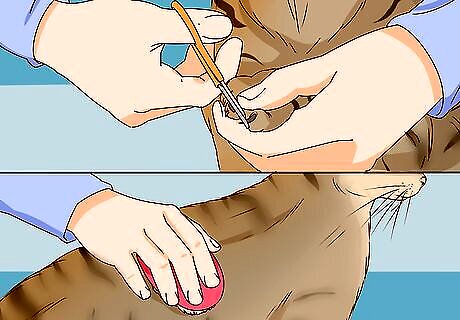
Trim the cat’s nails and brush out its fur. Prior to attempting to bathe the cat, make sure its nails are freshly trimmed. This will help prevent unwanted scratches when you do bathe the cat. Also before bathing, give the cat a thorough brushing. This will help remove any tangles in its fur, as well as any excess dirt or debris. You can also use a brushing session as a way to soothe and calm the cat before attempting to bathe it. If your cat doesn’t tolerate having its nails trimmed, consider having your veterinarian or a professional groomer do this for you.
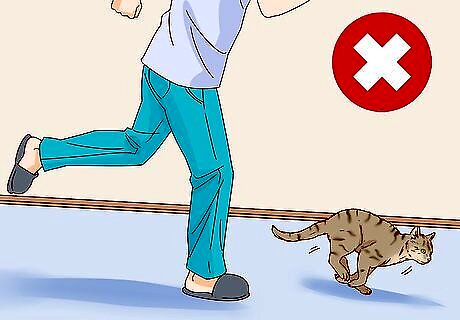
Avoid chasing or scaring the cat. It’s best to try and bathe your cat when its at its most calm. If you startle the cat by grabbing at it or chasing it, you might find it’s even harder to get through the bath itself. A soothing brushing session, lots of petting and speaking softly to the cat will help get the cat feeling more relaxed before you take it for its bath. You can also try to tire the cat out before the bath by playing with it for a while.
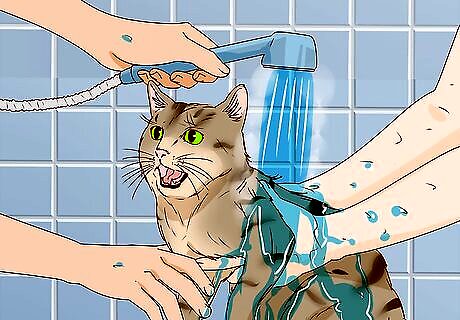
Ask a friend for help. When it comes to bathing a difficult cat, it’s always an easier experience when you have an extra set of hands to help you along the way. Ask a friend or family member to lend some help with bathing the cat. It helps if the person you ask is comfortable handling cats—especially angry ones. It may also help if the cat is familiar with the other person, so that they aren’t stressed out by the presence of a stranger.
















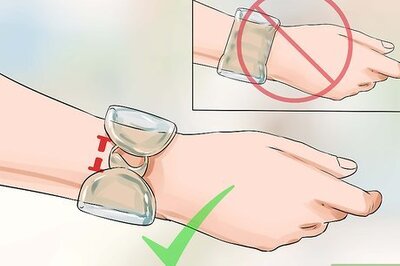

Comments
0 comment